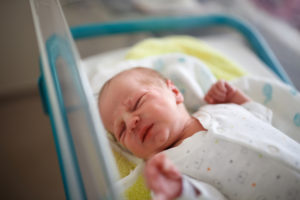
Did Your Child Suffer Injuries from HIE? Hire a Birth Injury Lawyer in St. Paul Now
For new parents, anticipating a baby is one of life’s greatest joys. But learning your child has suffered a birth injury, especially if your physician

Cerebral palsy, or CP, is a disorder or group of disorders which affects how the brain functions. This is caused by damage to the developing brain. The damage to the brain causing CP generally affects the ability of a person have to move. CP may also cause involuntary movements. There are several different types of cerebral palsy which are classified by the location and extent of damage to the brain. One specific type is athetoid cerebral palsy, which is also known as dyskinetic cerebral palsy. As Oregon athetoid cerebral palsy lawyers, we know that this type of cerebral palsy is particularly devastating.
Athetoid cerebral palsy is charactered by abnormal, involuntary movement. People with athetoid cerebral palsy may have unusually increased muscle tone (hypertonia) or unusually decreased muscle tone (hypotonia). Sometimes one state is more permanent than the other, but often times people with athetoid cerebral palsy will fluctuate between increased and decreased muscle tone. This causes a constant cycle of responding to the condition and new sets of disabilities and complications for a person and his or her family to combat.
Causes of Athetoid Cerebral Palsy
There are many different causes of athetoid cerebral palsy. While some of these causes may be due to genetic or natural birth complications, other times the causes of athetoid cerebral palsy may be due to Oregon medical malpractice and preventable birth injuries by healthcare providers. This is why it is important to seek the advice Oregon athetoid cerebral palsy lawyers to assess whether your loved one’s athetoid cerebral palsy was caused by either 1) unavoidable consequences, or 2) reckless, careless, or downright negligent medical care.
The most common causes of athetoid cerebral palsy caused by Oregon medical malpractice includes the following:
Types of Athetoid Cerebral Palsy
While there are many different types of cerebral palsy, there are also many different subsets of athetoid cerebral palsy. Each subset is premised on the location and extent of the damage to the developing brain. The different types of athetoid cerebral palsy include the following:
Dystonia athetoid cerebral palsy – This affects the torso, arms, or legs and causes slow, rotational movements.
Chorea athetoid cerebral palsy – This causes sudden, involuntary movements primarily in the fingers and toes, but it can affect other parts of the body.
Athetosis athetoid cerebral palsy – This affects mostly the fingers and face and is characterized by sluggish, writhing movements.
Choreoathetoid athetoid cerebral palsy – A mix of both chorea and athetosis, usually alternating.
Ataxia athetoid cerebral palsy – This causes tremors and shaky movement, usually causing a loss of balance and coordination.
Rigidity athetoid cerebral palsy – Unusually high muscle tone (hypertonia) which restricts and inhibits muscle movement.
Dyskinesia cerebral palsy – Used to describe involuntary movements which is why athetoid cerebral palsy is also known as dyskinetic cerebral palsy.
Symptoms of Athetoid Cerebral Palsy
Depending on the severity and subset of athetoid cerebral palsy, a person’s symptoms may differ greatly. In fact, generally speaking all types of cerebral palsy affect people differently. This is particularly true of athetoid cerebral palsy, as it is commonly understood that no two people share the same, exact symptoms of athetoid cerebral palsy.
But there are some common symptoms of athetoid cerebral palsy which include the following:
Bend/Portland, Oregon Athetoid Cerebral Palsy Lawyers
If you or a loved one have been seriously injured or killed as a result of medical malpractice contact the Oregon Medical Malpractice Lawyers at Kuhlman Law at our number below or fill out the intake form. We offer a free initial case evaluation and handle cases on a contingency fee which means that you pay no money unless we recover.
We handle cases throughout the state including Bend and Portland Oregon, Redmond, Central Oregon, Multnomah County, Deschutes County, Salem, Eugene, Corvallis, Lane County, Medford, Gresham, Albany, Medford, Beaverton, Umatilla, Pendleton, and Hillsboro.
We also have an office in Minneapolis, Minnesota and take medical malpractice cases throughout the Twin Cities, including St. Paul, Hennepin County, Ramsey County, Dakota County, Washington County, Anoka County, Scott County, Blaine, Stillwater, and Saint Paul Minnesota.
Please act quickly, there is a limited time (Statute of Limitations) in which you can bring a claim under the law.

For new parents, anticipating a baby is one of life’s greatest joys. But learning your child has suffered a birth injury, especially if your physician

Portland Medical Malpractice Lawyer Answers Can I Sue for Cerebral Palsy in Oregon Although no parent ever anticipates experiencing a catastrophic event during the birth

As patients in Minnesota, we put great trust in our medical professionals, and with good reason. Our healthcare system is one of the finest in

As a parent, there is little more devastating than finding out your child has suffered a brain injury. You’re experiencing various emotions – sadness, anger,

Portland Medical Malpractice Lawyer Explains Failure to Treat a Stroke in Oregon A Portland medical malpractice lawyer can help you handle many different types of

You had complete faith and trust in your care team during your pregnancy and delivery, but now, you’re not so sure. Your baby has been